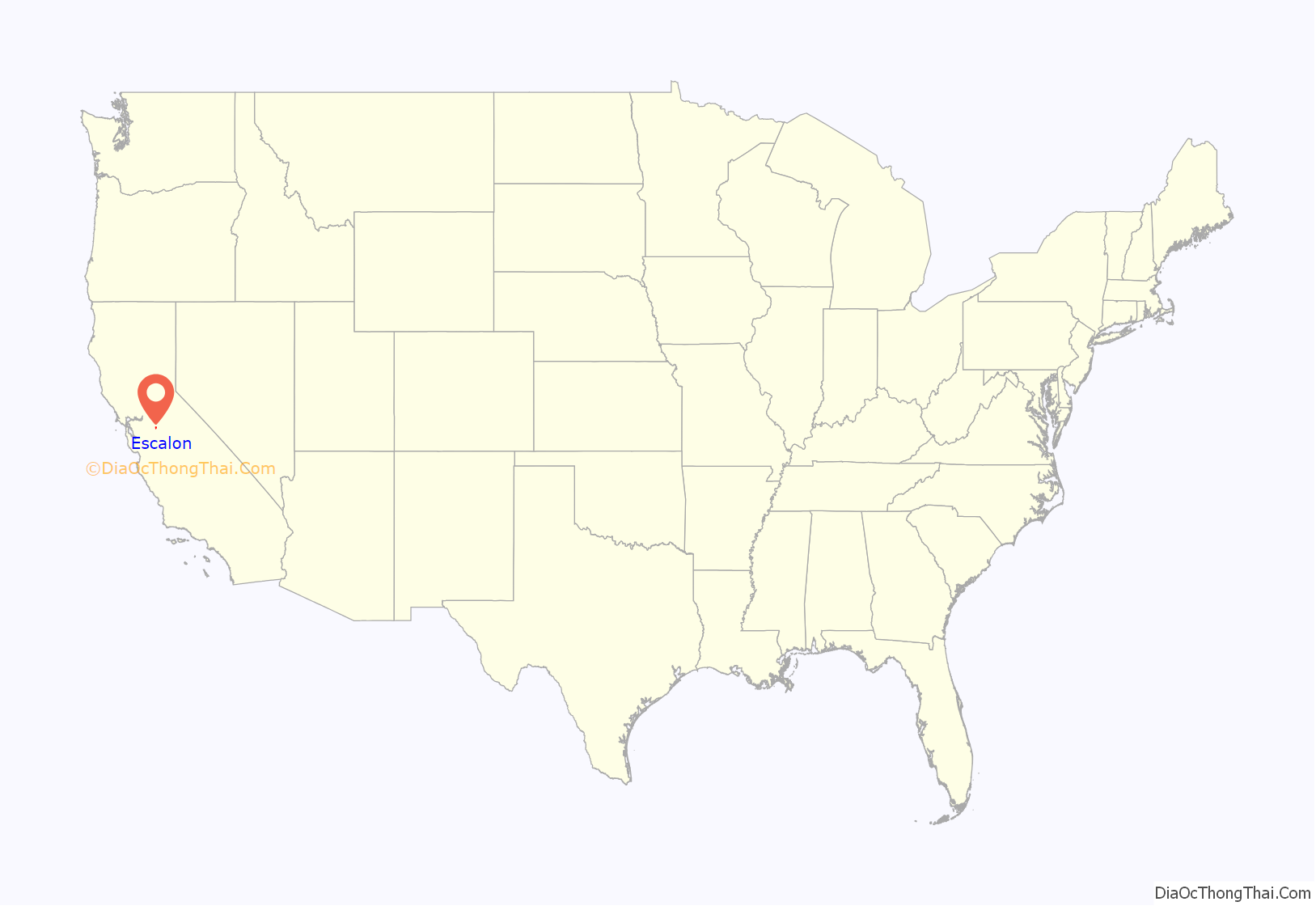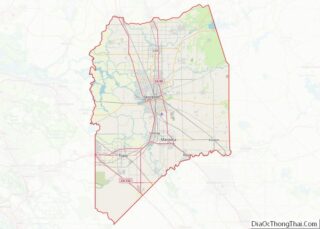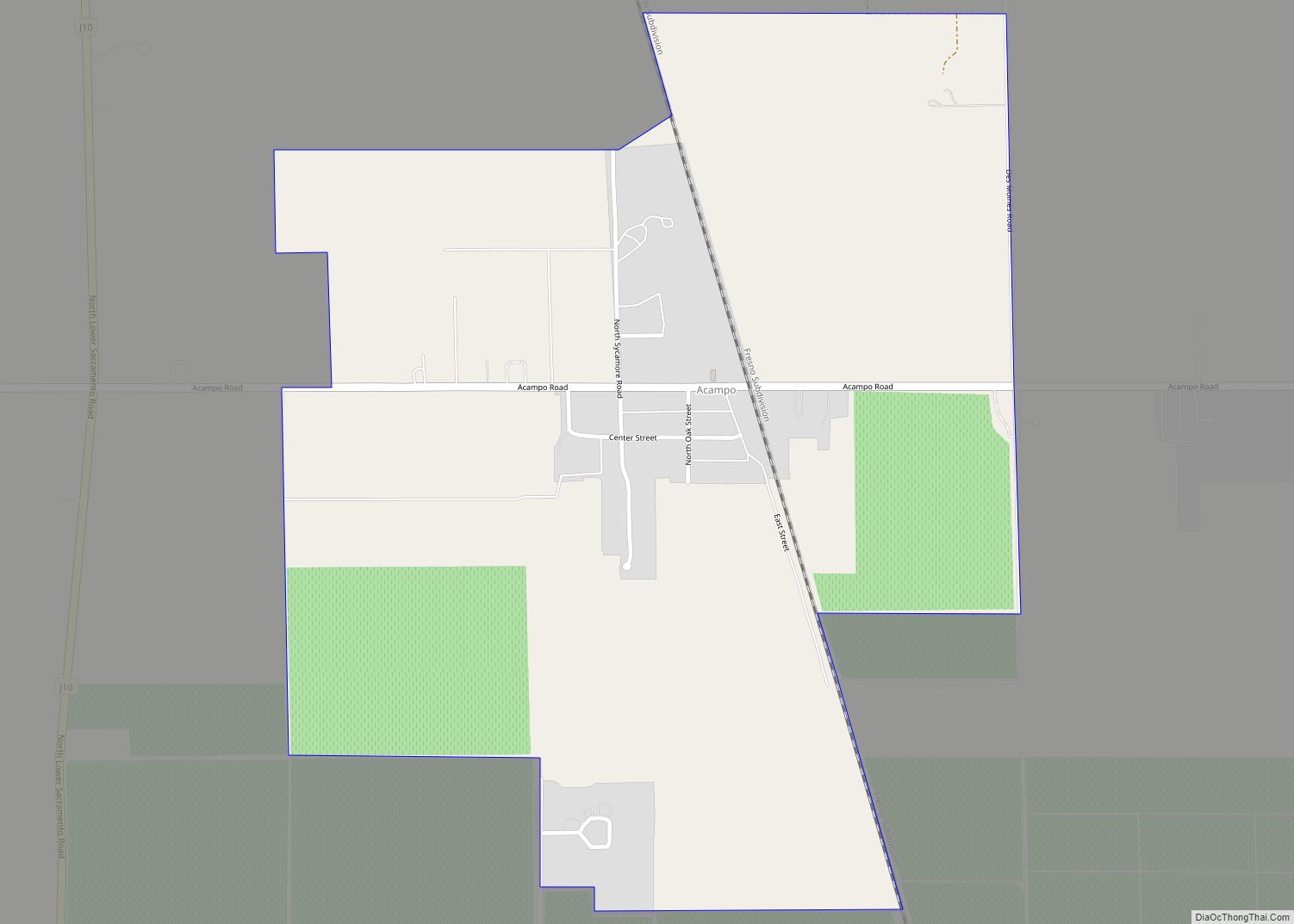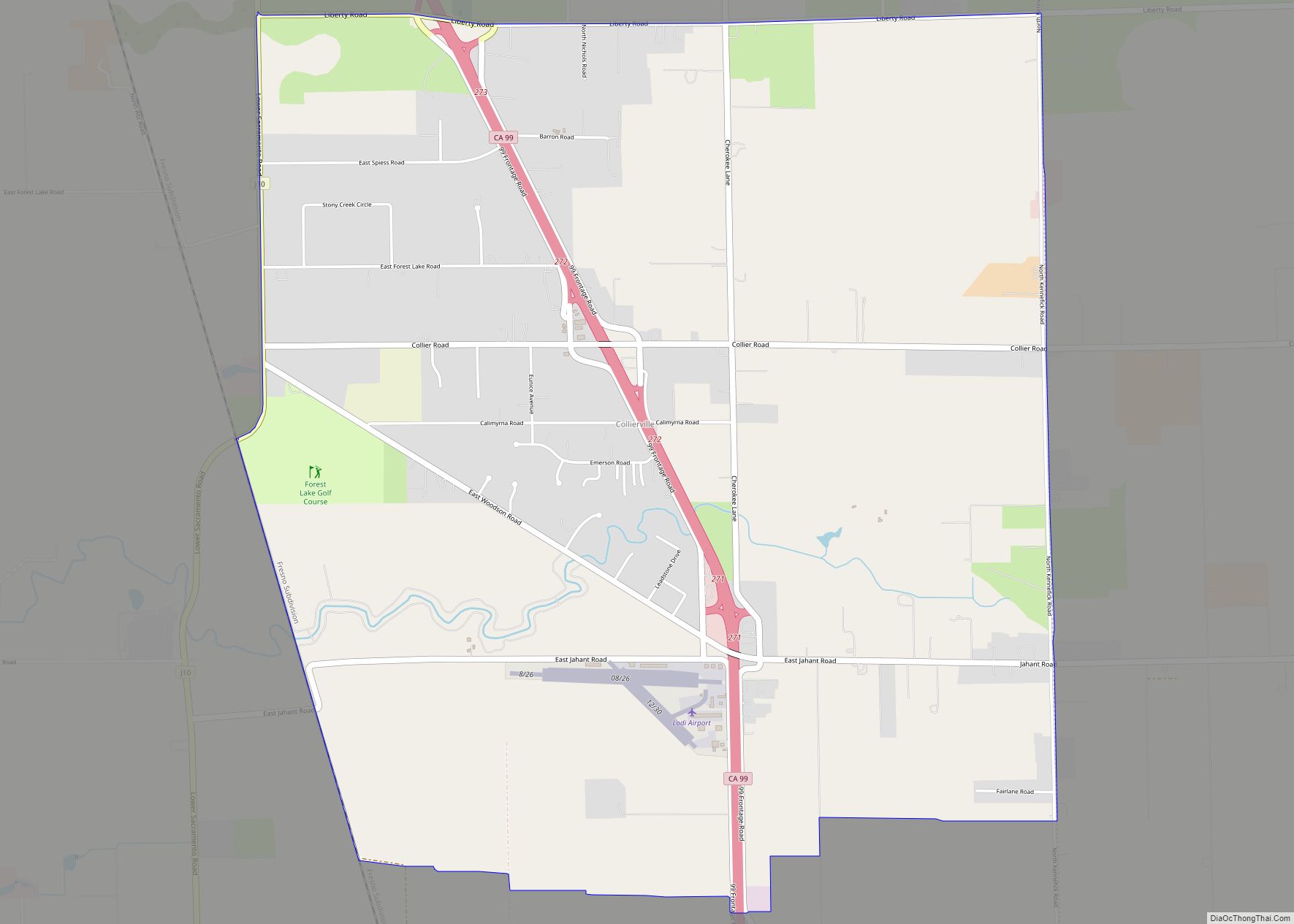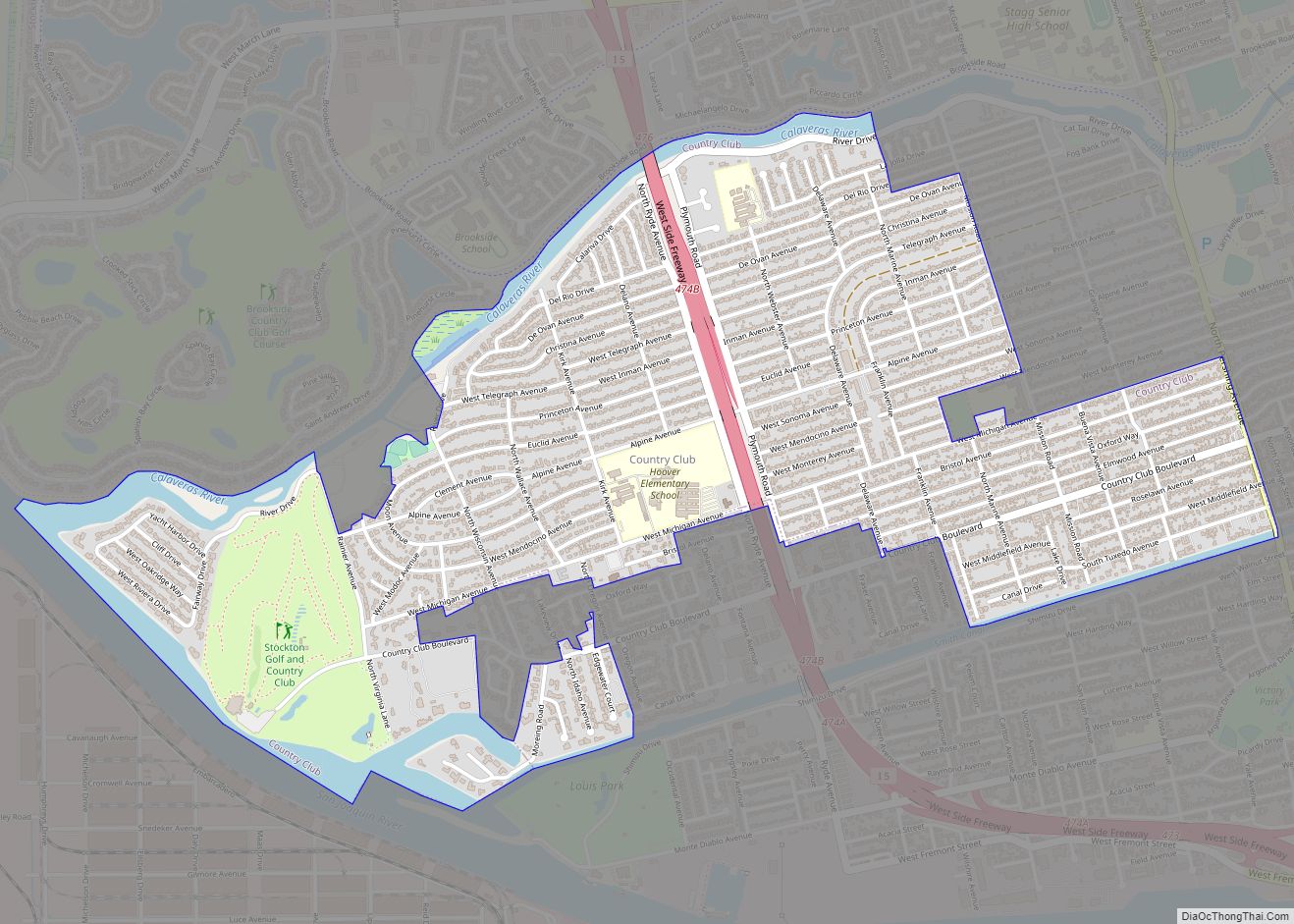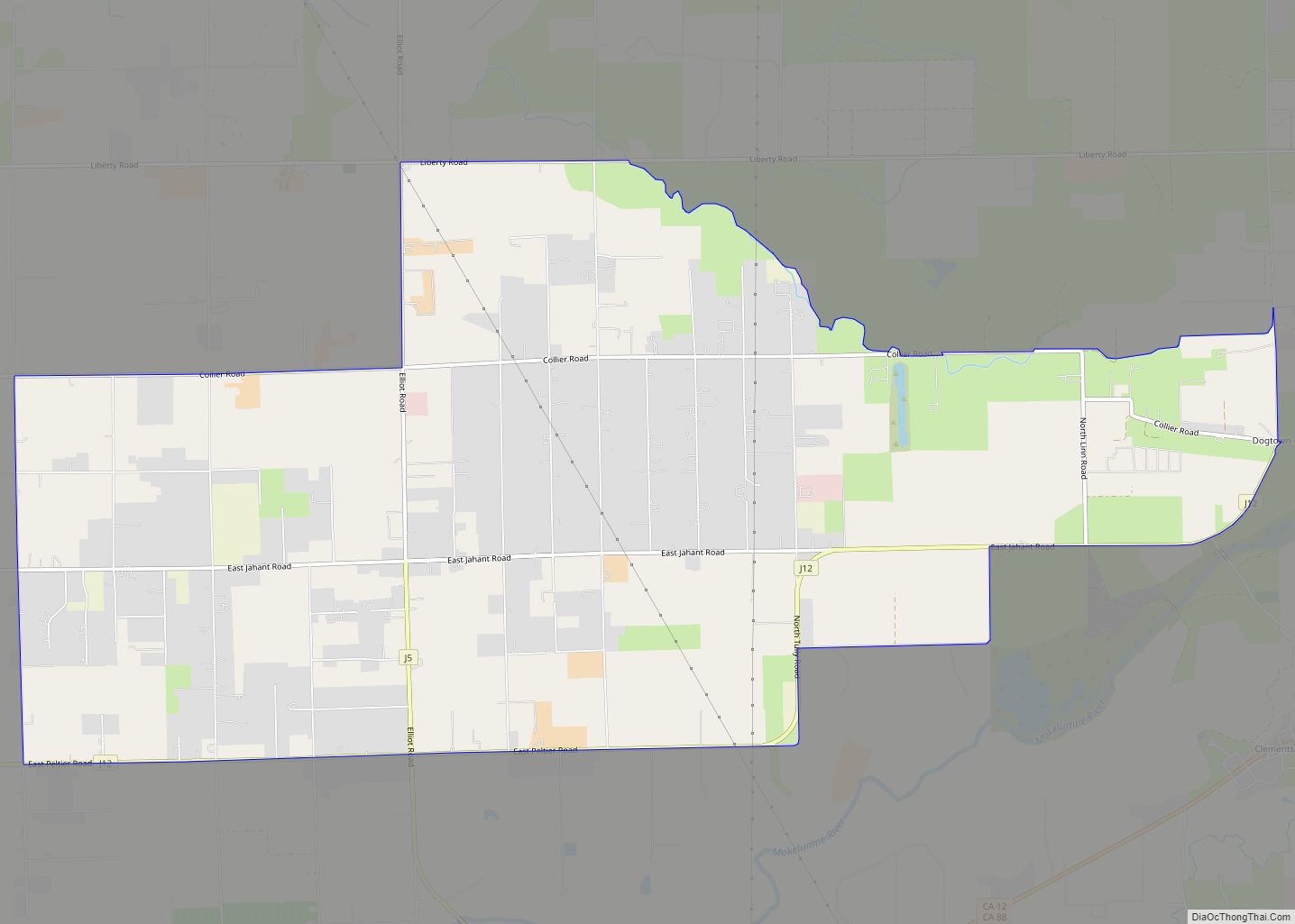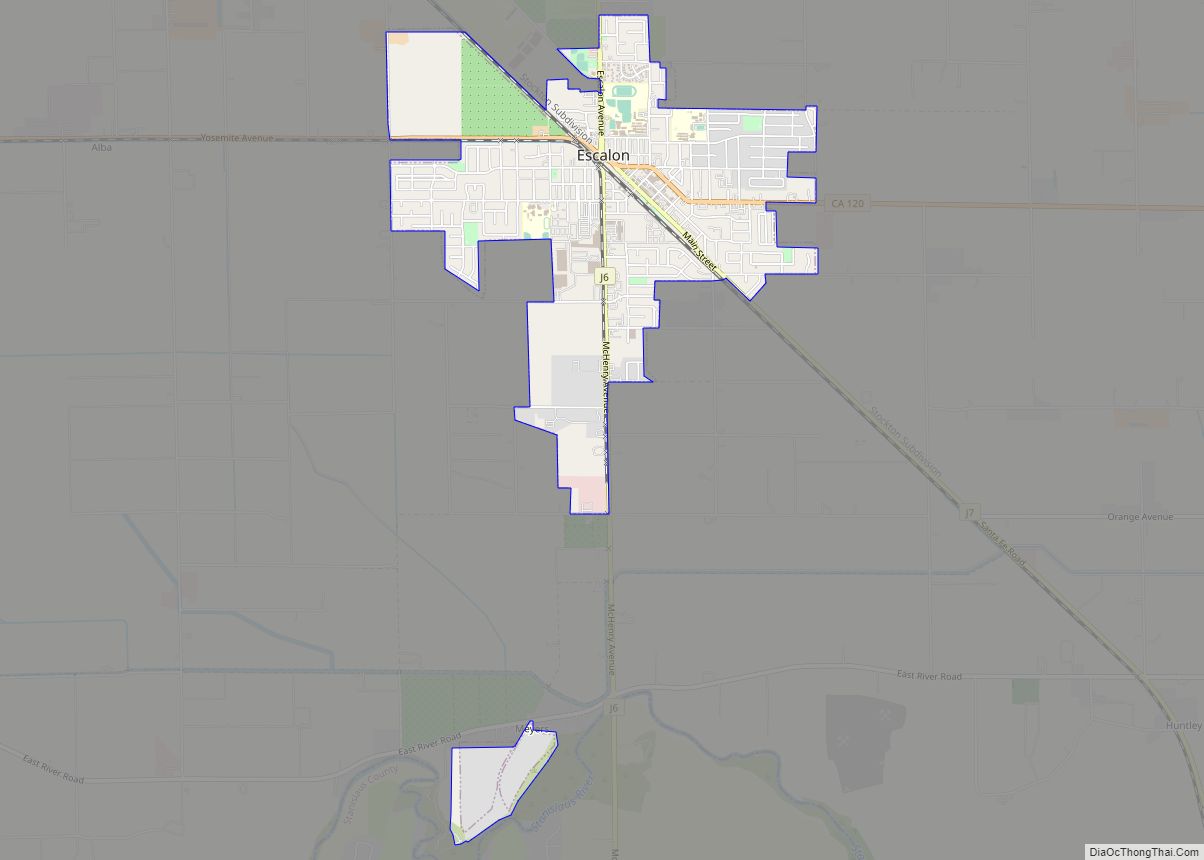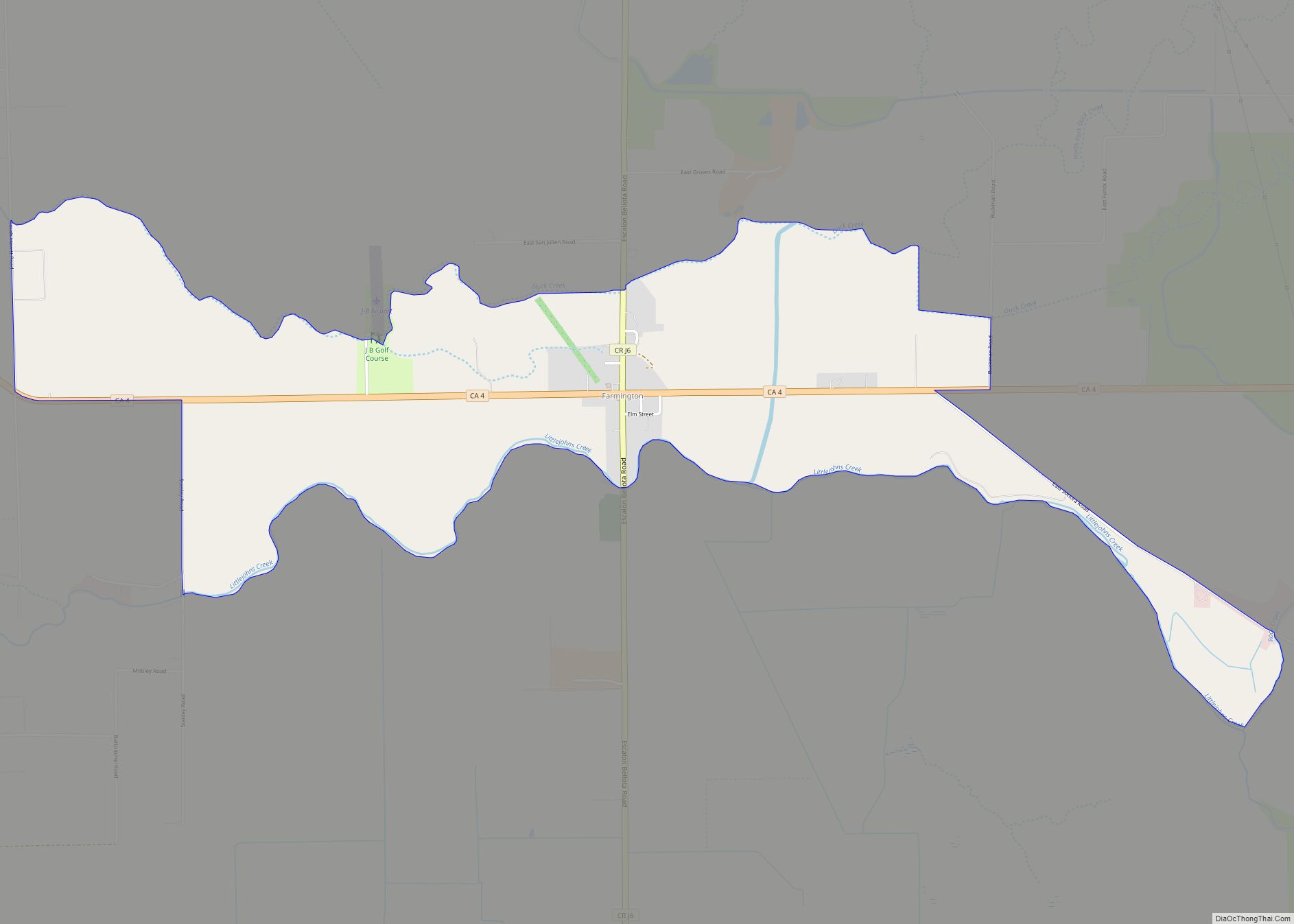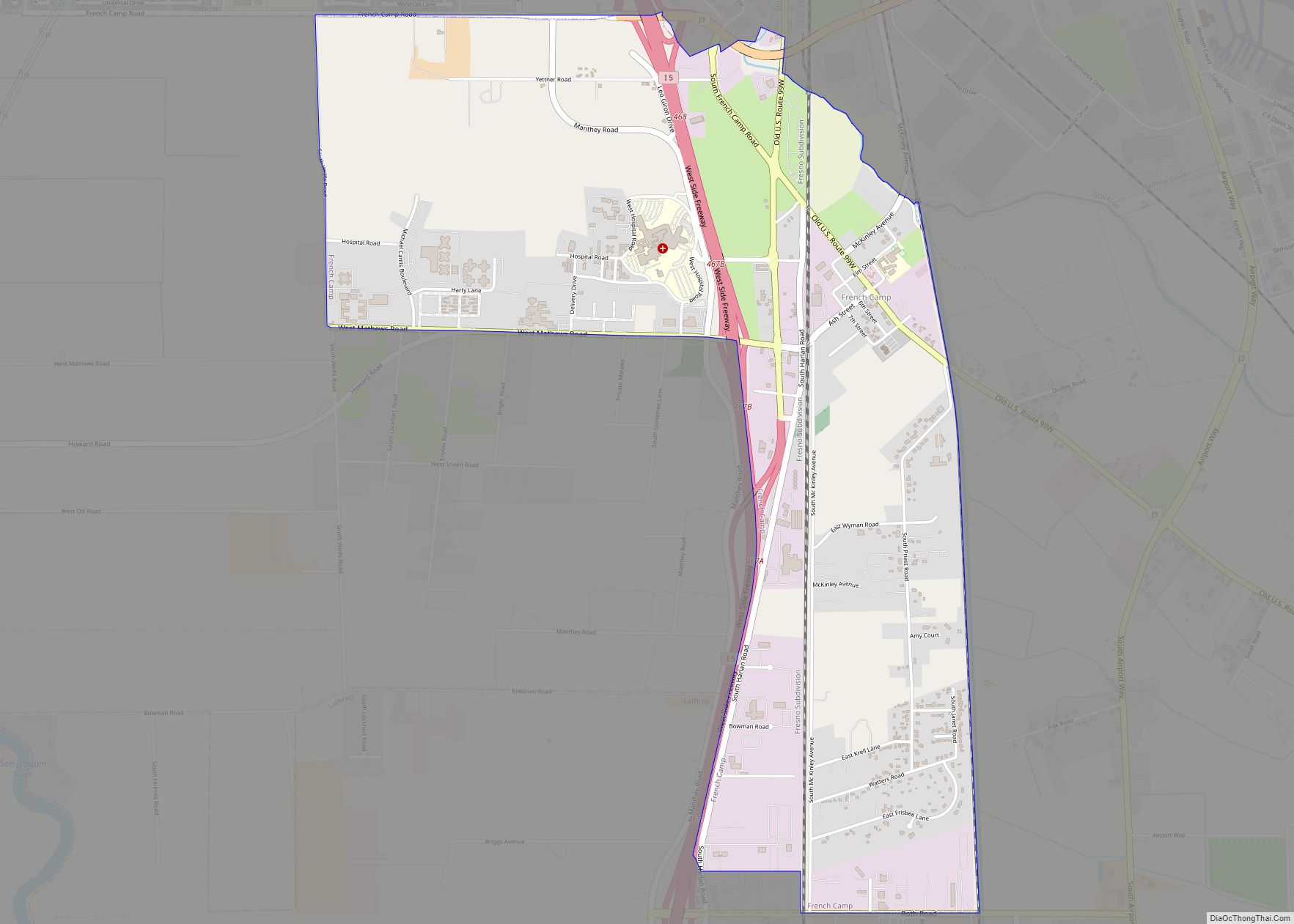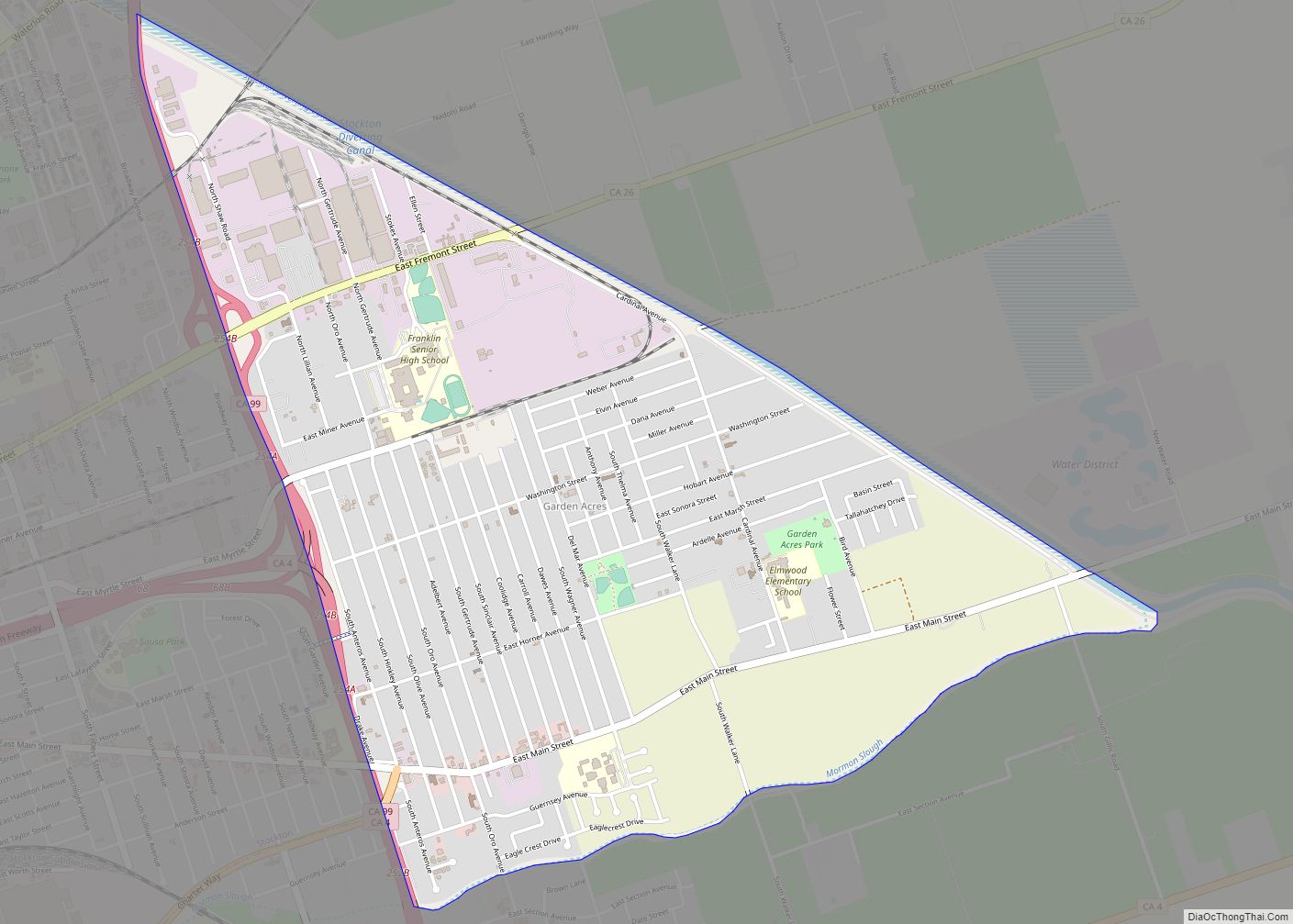Escalon (Spanish: Escalón, meaning “Step”) is a city in San Joaquin County, California, United States. The population was 7,132 at the 2010 census, up from 5,963 at the 2000 census. Escalon is a Spanish word meaning “stepping stones.” The name comes from founder James Wheeler Jones who came upon the name in a book in the Stockton Free Library and liked the name so much he gave the name to the town.
| Name: | Escalon city |
|---|---|
| LSAD Code: | 25 |
| LSAD Description: | city (suffix) |
| State: | California |
| County: | San Joaquin County |
| Incorporated: | March 12, 1957 |
| Elevation: | 118 ft (36 m) |
| Total Area: | 2.35 sq mi (6.08 km²) |
| Land Area: | 2.28 sq mi (5.90 km²) |
| Water Area: | 0.07 sq mi (0.17 km²) 2.85% |
| Total Population: | 7,472 |
| Population Density: | 3,321.93/sq mi (1,282.85/km²) |
| ZIP code: | 95320 |
| Area code: | 209 |
| FIPS code: | 0622790 |
| GNISfeature ID: | 1656002 |
| Website: | www.cityofescalon.org |
Online Interactive Map
Click on ![]() to view map in "full screen" mode.
to view map in "full screen" mode.
Escalon location map. Where is Escalon city?
History
Before the advent of the railroad, the traveler in riding over the French Camp road to the Stanislaus River would notice far out on the plains a large two-story brick house. It was surrounded by trees and shrubs, barns, granaries, and was the only house for miles around. It was the home of “Johnny” Jones, who crossed the plains in 1852 and pitched his tent where Escalon now stands, the country at that time being Government land covered with sage brush. He acquired the amount of land allotted to actual settlers and started to farm it, planting the first grain ever grown in the Escalon country, seeding it broadcast and dragging it in with brush. The yield was heavy and sold for five cents a pound. He began raising cattle for market and purchasing more land until he possessed a small kingdom, 8,000 acres, a tract of land over three miles square. It was no unusual sight to see from six to twelve-horse teams plowing over the field where Escalon now stands. In 1867 he built the brick house for his family residence at a cost of $12,000. The bricks used for it were made by his brother Richard, from a field east of Sexton station, on the Tidewater Railroad. In those days all freight carried from Stockton to the mines above Sonora went via the French Camp road, and many of the teamsters boarded and lodged at his farm. The plains were the homes of many antelope, which he often served on his table.
Escalon is a Spanish word meaning stepping stones. What relation it has to the town is difficult to imagine. James W. Jones, the founder of the town, is said to have seen the name in a book in the Stockton Free Library and pleasing him he gave the name to the place. His father died in 1893, leaving quite a fortune. He willed the old home place to James W., together with the adjoining 1,000 acres. The land at that time was not of any great value, but in the following year along came the Valley Railroad, recorded in another chapter, and the land began to increase in value. As soon as Mr. Jones was assured of the railroad crossing the land he engaged a surveyor and laid off the town. The boundary lines run nearly north, south, east and west, but the streets run diagonally, thus some blocks are square, others oblong, some are rectangular and several blocks are triangular in shape.
John McGinnis, in recording some of the first events in Escalon says, “In the month of August, 1894, I was accosted, in Stockton, by a promoter of the townsite, Mr. Harlon, and was prevailed upon to make the trip to Escalon. The four-horse stage was brought forward by the hostler and James Jones, popularly called ‘Jim, ‘took the ribbons. Leaving there about 9:00 o’clock A. M., driving out the old French Camp Road, we arrived at the Jones home place, the brick house, about noon. With hospitality, an attribute of the Jones family, we sat down to a feast, fit for a king, and did full justice to it. We afterwards walked over and viewed the townsite, east of the then only graded roadbed. It was graded by a railroad company called the ‘Valley Road.’ We then passed, through a thrifty vineyard, the very first vines to be propagated by Johnny Jones — ‘Jim’s’ father. We then passed the Jones’ blacksmith shop just east, across the road from where the Tidewater depot used to be located. I again visited Escalon in 1900. There was then a depot, a store had been built but had not opened for business, the pioneer saloon, and. a temporary hotel on the Jackson property, also used as a dwelling and post office, Mrs. Jackson being postmistress.”
As soon as the town was surveyed Mr. Jones built a good sized hotel to accommodate the prospective buyers who came by stage from Stockton, which was located about where the Presbyterian Church now stands. The first Santa Fe train rolled into Escalon in the spring of 1896. The post office and the first store were started by Mrs. Charles Jordan, wife of the station agent, on ground now occupied by the Tuolumne Lumber Company. The second store was built by Nelson Leighton, a large two-story building facing the railroad with a hall above used for social functions. Mr. Leighton installed in his store the first telephone switchboard in Escalon. The first warehouse was built by David L. Jones and John A. Coley in 1897, and another was built later by Haslacher & Kahn, of Oakdale. The first long-distance telephone was installed in John Coley’s residence ; and he was the first real estate agent and grain dealer in the town, and built many of the dwellings for rent and sale.
The Escalon Commercial Club, formerly known as the Escalon Board of Trade, was organized March 11, 1911, with the following officers: A. St. John, president; C. H. Sheldon, vice-president ; H. L. MacPherson, secretary ; and R. N. Haines, treasurer. They carried out successfully a Fourth of July celebration in 1913, were active in the formation of the irrigation district, saw the Union high school erected, installed a lighting system; succeeded in getting the supervisors to lay some splendid streets, the town not being incorporated, and held a successful community fair in 1917. The following are the past officers of the club elected in June, 1912: H. L. MacPherson, president; S. J. Irvin, vice-president; O. A. Fish, secretary ; and W. F. Searcy, treasurer ; September 8, 1914, H. L. MacPherson, president; J. H. Martin, vice-president; E. AV. Bidwell, secretary; A. Kerr, treasurer; October 16, 1916, H. L,. MacPherson, president; E. W. Bidwell, vice-president; H. L. Morgensen, secretary; and Dr. J. M. Carr, treasurer; March 10, 1917, John R. Martin, president; S. R. King, vice-president; H. A. Bierschal, secretary; and C. Moorehead, treasurer.
The school was first opened near the celebrated lone tree as early as 1878. It was in session only six months of the year, with an enrollment of 31 boy’s and girls, with an aver- age attendance of 15 pupils. After the. founding of Escalon the school district was divided, and a new district school started in the new town. The trustees of the new district, two of them, AV. A. Owens and J. A. Coley, succeeded in getting the people to bond the district for a small sum and the money was used in purchasing a lot about 1903 and erecting a two-room schoolhouse. The first teacher, Miss Stella Reynolds, had formerly taught the Lone Tree school, with splendid success. The school has had a steady and substantial growth during the past decade and in 1914 it was found necessary to provide larger accommodations for the pupils. The citizens cheerfully voted more bonds, the present grammar school grounds were purchased and a hand- some building constructed of hollow tile. The number of scholars continued to increase and last year an additional four class rooms were built’ at a cost of $18,000. The entire building was then covered with mastic. One, of the features of the additional rooms was an assembly hall seating about 400 persons which can be used as a public auditorium. Mrs. Grace Taylor Pearce has been principal for the past nine years and under her administration the school has been placed on the accredited list of the county.
It was not until 1916, says Prof. Oliver E. Irons, that the citizens realized the necessity of a high school. The Escalon Commercial Club took the matter in hand and carried on an active bonding campaign. Although they put in plenty of hard work the proposition was defeated by just three votes. In 1919 the club was more successful and at the bond election, May 16, the bonds for a high school carried by a large majority. Immediately a school board of five members were elected, namely, AV. L. Cooms, C. A. Smith, H. L. Morgansen, Otto Peterson and H. H. McKinney, and they have held their offices elected time and again up to the present date.
The Jones club house was secured and school was started in September with Mr. F. AA. Denny and Mrs. A. Cowan as instructors. Mrs. Cowan resigned in mid-year and her place was taken by Miss Orr. The total enrollment the first year was thirty-five. In the second year the enrollment of seventy-five pupils overtaxed the seating capacity of the club house and the citizens of the district voted a bond of $85,000 for suitable high school rooms. The building was completed early this year with the following teachers in charge : Oliver E. Irons, principal ; Paul B. Boehnecke, Miss Nydia Jensen, Miss Minnie Smith, Miss Ruth Williams, and Miss Stella Barnett, under whose able instructions all classes are progressing rapidly.
The Methodist Church has the distinction and honor of being the first church in Escalon. All other churches now found in Escalon have branched out of this church, so declared the Rev. C. G. Zierk. The church was organized in the Lone Tree section in 1893, during the pastorate of the Rev. John Stevens, later for five years pastor of the Central Methodist church of Stockton. While the church was at Lone Tree Corners, it was on a circuit with Farmington, Atlanta, Riverbank and Oakdale. It remained at Lone Tree Corners until September 1908, when the building was moved to Escalon. This building stood on the site of the present church until it was torn down to make room for the new structure, which was completed and dedicated on Sunday, April 10, 1921. Since it has become a separate charge the following pastors have been appointed here: U. L. Walker, L. H. Sanborn, Luther Speers, Smith, McWilliams, A. Z. Bose, S. L. Lee, G. W. Grannis, L. H. Jenkins and C. G. Zierk.
The Evangelical Lutheran Church was organized November 15, 1909, by the Rev. Phillip Andreen of San Francisco, assisted by David Magunson of Stockton. Subscriptions were obtained in November, 1911 and a building was erected, just west of the old school house in 1913. It was dedicated in the summer of the following year, 1914. The following pastors have been in charge, the Rev. W. X. Magnuson, 1912, Dr. P. E. Berg,. 1913; Rev: C. Anderson, 1916; Rev. N. P. Anseen, 1921 : Rev. O. W. Westhng-, 1922.
The Presbyterian Church was organized November 10, 1913, with the following charter members : Mr. and Mrs. Wm. Campbell, Miss Margaret Campbell, Miss Helen Campbell, Mr. S. H. Irwin, Mrs. Minerva H. Erwin, Mr. and Mrs. E. W. Bidwell, Mrs. O. A. Fisk, Miss Leona Kelley, Miss Hazel Delley, Mr. and Mrs. E. A. Clough, Mrs. J. G. Voorhies. Of the original members, ten remain and are living in and around Escalon, three have moved away, and one is deceased. Services were first held in the Community hall, but in 1915 the trustees purchased the pioneer gram- mar school building and fitted it up for church purposes. The first pastor. Rev. E. B. David- son, served until October 1, 1915, and during the succeeding two month the pulpit was occupied by the Rev. A. M. Wood, then the Rev. I. B. Surface was pastor until December 1, 1916. In March, 1917, the Rev. A. L. Bone took charge and installed the following year.
Escalon came into being in the late 1800s because of the agricultural production in the immediate area and the need to get products of that agriculture to market by railroad. John Wheeler Jones settled here with his family on the 1850s, and his son, James Wesley Jones, laid out the community of Escalon 40-plus years later. Although Escalon was incorporated in 1957, celebrating its 50-year anniversary in 2007 by proclamation of Escalon’s city council, 1994 was officially acknowledged as the year to celebrate the Escalon centennial.
In 1898, the Santa Fe Depot was constructed (along the San Francisco and San Joaquin Valley Railroad line) and operated until 1970. It was located alongside the Santa Fe Railroad Tracks that bisect the heart of Escalon near Main Street’s intersections with Second Street.
In 1909, Oliver A. Fisk began construction on the Fisk Building, completing it in 1911. This building is still located at the corner of Main and First Streets in its modified form. The first to occupy this building was the Escalon State Bank, the first bank in town, in 1912. The bank was established by S.J. Irwin, the owner of the Irwin Lumber Company.
Escalon Road Map
Escalon city Satellite Map
Geography
Escalon is located at 37°47.5’N 120°59.5’W (37.7984,-120.9969), where State Highway 120 crosses the BNSF railroad. According to the United States Census Bureau, the city has a total area of 2.4 square miles (6.2 km). 2.3 square miles (6.0 km) of it is land and 2.85% is water.
See also
Map of California State and its subdivision:- Alameda
- Alpine
- Amador
- Butte
- Calaveras
- Colusa
- Contra Costa
- Del Norte
- El Dorado
- Fresno
- Glenn
- Humboldt
- Imperial
- Inyo
- Kern
- Kings
- Lake
- Lassen
- Los Angeles
- Madera
- Marin
- Mariposa
- Mendocino
- Merced
- Modoc
- Mono
- Monterey
- Napa
- Nevada
- Orange
- Placer
- Plumas
- Riverside
- Sacramento
- San Benito
- San Bernardino
- San Diego
- San Francisco
- San Joaquin
- San Luis Obispo
- San Mateo
- Santa Barbara
- Santa Clara
- Santa Cruz
- Shasta
- Sierra
- Siskiyou
- Solano
- Sonoma
- Stanislaus
- Sutter
- Tehama
- Trinity
- Tulare
- Tuolumne
- Ventura
- Yolo
- Yuba
- Alabama
- Alaska
- Arizona
- Arkansas
- California
- Colorado
- Connecticut
- Delaware
- District of Columbia
- Florida
- Georgia
- Hawaii
- Idaho
- Illinois
- Indiana
- Iowa
- Kansas
- Kentucky
- Louisiana
- Maine
- Maryland
- Massachusetts
- Michigan
- Minnesota
- Mississippi
- Missouri
- Montana
- Nebraska
- Nevada
- New Hampshire
- New Jersey
- New Mexico
- New York
- North Carolina
- North Dakota
- Ohio
- Oklahoma
- Oregon
- Pennsylvania
- Rhode Island
- South Carolina
- South Dakota
- Tennessee
- Texas
- Utah
- Vermont
- Virginia
- Washington
- West Virginia
- Wisconsin
- Wyoming
